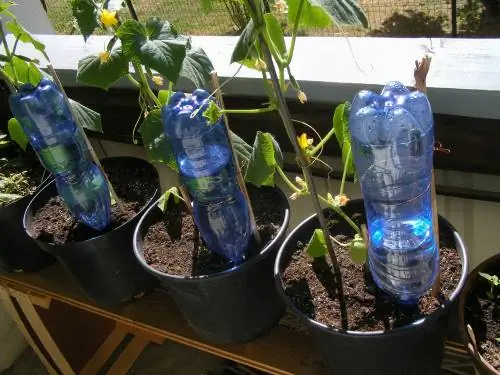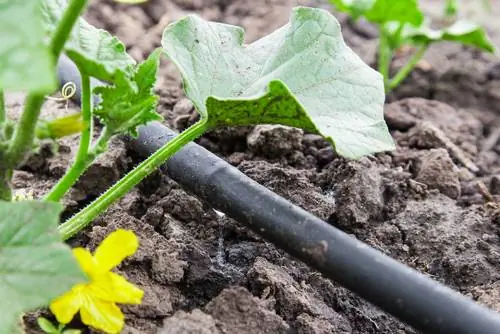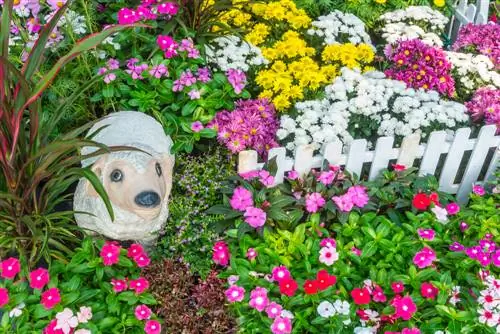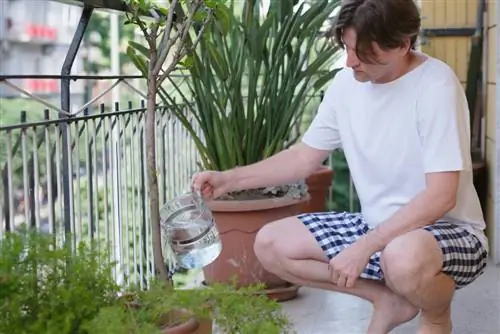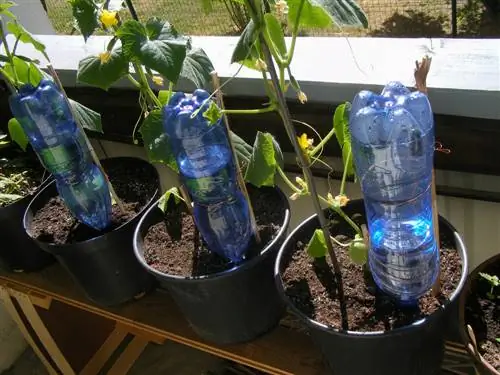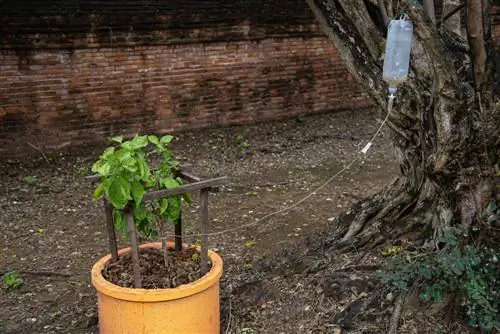- Author admin [email protected].
- Public 2023-12-16 16:46.
- Last modified 2025-01-23 11:22.
If you are away from the house for a long time, you don't have to worry about your plants. There are numerous ways you can automate your water supply. This works with finished sets or self-built models.

How does automatic watering for plants work?
Automatic irrigation provides plants with continuous water when they are away. Solutions range from simple PET bottle systems for houseplants to programmable drip irrigation systems for larger areas such as greenhouses and lawns.
Where does automatic watering make sense?
Golf courses and landscape gardens are irrigated automatically. There are now such systems for home gardens that make watering with a hand shower unnecessary. Self-contained irrigation systems are effective and save water. Irrigation systems are suitable for all plants that prefer fresh to moist conditions.
There is a wide range of products not only for the kitchen garden but also for potted plants indoors or on balconies and terraces. While underground water pipes are laid in the garden, drip irrigation systems supply the plants on the balcony, in the greenhouse or terrarium.
The diversity of automatic systems:
- Houseplants: Weekend or holiday watering
- Lawn: even surface irrigation with sprinklers
- Hedges: continuous humidification through drip irrigation
- Raised bed: targeted irrigation of seedlings
- Greenhouse: constant water supply for peppers and tomatoes
- Bonsai: micro-irrigation system or self-made water supply
Build your own automatic irrigation
If you are planning a longer absence and couldn't find a watering aid, you can build your own irrigation systems with just a few resources. These DIY alternatives are suitable for small pots as well as large raised beds or greenhouses.
Automatic irrigation systems are easy to build yourself. All you need is water transportation and a water supply.
Houseplants: PET bottle
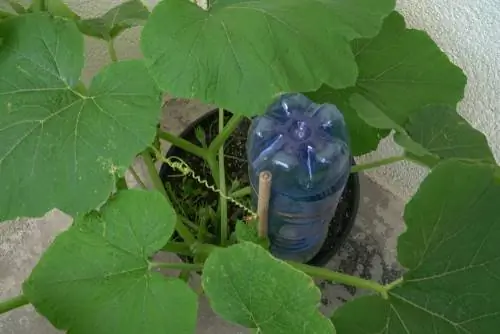
The PET bottle is a good option for thirsty indoor plants
Fill a PET bottle with water and insert a special irrigation cone (€11.00 on Amazon), which you can buy from specialist retailers, into the opening. There are attachments made of porous clay or plastic with holes. The bottle is then inserted with the attachment into the substrate of potted plants. Moisture is continuously released through the material.
Advantages and disadvantages
Watering cannot be adjusted to the plant's water needs, which can result in over- or under-supply. It is only suitable for houseplants because the environmental conditions are more uniform and water loss through evaporation can be controlled. This automatic system can cover a period between eight and 25 days, depending on various factors:
- Porosity determines how quickly or slowly the water seeps through
- Bottles have different capacities
- warm ambient temperatures increase water evaporation
Material selection
Which attachment you choose does not just depend on price and durability. The PET bottle to be used also influences the decision. Plastic attachments work better with solid plastic bottles. Soft bottles collapse due to the negative pressure in the bottle, which allows the water to escape too quickly. Clay attachments usually do not fit on all bottles.
| Plastic | Sound | |
|---|---|---|
| How it works | Water seeps through small holes | Water diffuses through porous structure |
| Special feature | Irrigation only works with negative pressure | Bottle needs a hole to equalize the pressure |
| Advantage | cheap and fits every bottle | very consistent water supply |
| Disadvantage | Holes clog easily | mostly only fit on thin-walled bottles |
Balcony plants: suction hose
Plants on balconies and terraces consume more water if they are exposed to direct sunlight. Temperature fluctuations cause irregular moisture loss. Therefore, an automatic irrigation system must ensure a larger water supply. You can easily implement this variant:
- Place the clay cone with the suction hose into the substrate
- Place the end of the suction hose in a bucket
- Fix the hose with stones
- Fill bucket with water
This irrigation adapts to water needs. The water is sucked out of the reservoir as the substrate around the clay cone dries out. The clay cones work without electricity because the water is sucked into the dry earth by capillary forces.
Excursus
How the clay cone sucks in water
Capillaries are tubes with a very small inner diameter. Compared to thicker pipes, certain surface effects occur here. The effect of capillarity causes liquids with a high surface tension to rise in the thin tubes. The smallest pores in the substrate are also known as capillaries. Thanks to the adsorption forces, the water remains in the pores. If it is used up by the plants, the capillary forces suck in new water.
Bonsai: fabric strips
If you are only away for a short time, you can provide your bonsai trees with water using simple means. Place the bowl on a brick in a plastic tray over the weekend. This is filled with water so that the water level does not reach the bowl. Place several strips of fabric from the plant substrate into the water. They soak up water and transport moisture to the roots without causing waterlogging.
Finally on vacation - but wait a minute, what will become of the balcony plants?! Unfortunately, there is no takeaway, but what could be the solution? Here are my ultimate tips for holiday watering on the balcony! Link in profile? balconylove holidayirrigation gardenblog irrigationsystem
A post shared by Garten Fräulein (@gartenfraeulein) on Jun 22, 2019 at 2:30am PDT
Raised bed: clay pots
In Africa, people have been using clay pots to constantly water their plants for centuries. The so-called Ollas are used here. These bulbous vessels narrow towards the opening and can be closed with a lid or stone so that neither dirt nor insects accumulate in the water. The clay vases are completely buried in the substrate up to the opening and filled up to the neck with water. You can use any clay pot that meets these requirements instead of the ollas:
- no glazing or painting
- without drainage hole in the bottom
- narrow opening and bulbous shape
Tip
Bury the clay pot so that it sits in the middle of four plants. If the root system is not yet very well developed, you should initially water the young plants additionally.
Greenhouse: droplet system
If the plants in the greenhouse are already so large that you would damage the roots by burying clay pots, you can build your own above-ground drip irrigation system. To do this you will need a plastic bottle, several thin irrigation hoses, a water supply, clamps and stones.
Instructions for building your own:
- Drill holes in the bottom of the bottle
- Put the tubes in and fill the bottle with stones
- Put the bottle in a rain barrel
- Reduce the size of the hose openings with a clamp so that the water only drips out
- Suck in water and place hoses around the plants

What products are on the market?
The online search will quickly direct you to the market leader Gardena. But it's worth comparing the competition's products. Cheaper systems from lesser-known manufacturers are often sufficient for houses and balconies.
Gardena
The manufacturer has a wide range of different irrigation systems that automatically water the entire garden. There are also microsystems that supply water to balcony and house plants. The systems can be expanded as desired with hoses and plug connections. Additional elements such as pressure reducers, filters or control computers offer individual solutions.
Features at a glance:
- high quality but expensive
- work with pump and storage container or with water connection
- cannot be operated without electricity
Grow
In the online shop you can buy complete sets for automatic irrigation, which are available from around 30 euros. These systems work with a pump and provide the plants with drip irrigation directly at the roots. You can also put together your own system from a water pump, hoses and storage container. The products are suitable for watering potted plants and can also be used in the greenhouse.
Programmable Systems
If you want to be precise, you can buy a basic device yourself, program it and connect it to an irrigation system. The system independently measures soil moisture at regular intervals and controls the irrigation valves. You can determine the minimum and maximum water requirements yourself and thus adapt the irrigation to different plants.
Arduino or Raspberry Pi are full-fledged computers in mini format that can be programmed. An additional sensor is required so that the moisture in the substrate can be measured. This can be built yourself from a tube filled with plaster and two nails or purchased as a whole.
How it works:
- Power supply via power supply, batteries or solar modules
- Water supply as needed
- Solenoid valves are opened or closed by measuring humidity
Tip
There is a tutorial from E-Zubis with which you can easily build and program a system yourself.
Frequently asked questions
How can I water my houseplants while on vacation?
You can build your own irrigation system using a PET bottle. You can either use clay or plastic attachments, or hang an absorbent string in the bottle filled with water. The other end is buried in the substrate close to the base of the plant so that water is automatically pumped from the bottle to the roots.
Are there automatic irrigation systems for raised beds and greenhouses?
You can equip the plants in the bed and greenhouse with a drip irrigation system or a sprinkler system. Both models are connected to a tap and can be equipped with a timer. Homemade models use capillary forces and work without electricity. A simple solution is clay jars that are buried in the ground.
What do I have to consider with an irrigation system for the lawn?
Thorough planning is important here. First, find out how much water and what water pressure is available. These factors change depending on the distance between the water connection and the irrigation valve. The choice of system and the placement of the individual elements also determine the success of irrigation.
How much does automatic irrigation cost?
These depend on the system chosen and the planned area of application. Complete systems for watering individual potted plants are available from just 30 euros. Expandable systems for beds and greenhouses that can be individually designed cost around 50 to 100 euros. The costs for watering your lawn can be significantly higher.

